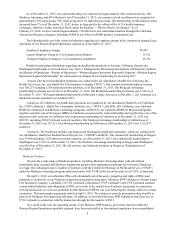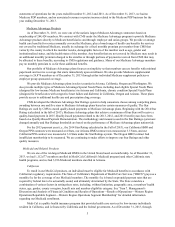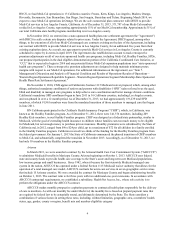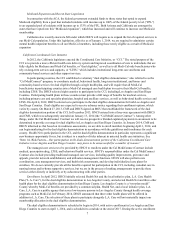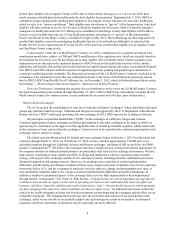Health Net 2013 Annual Report Download - page 16
Download and view the complete annual report
Please find page 16 of the 2013 Health Net annual report below. You can navigate through the pages in the report by either clicking on the pages listed below, or by using the keyword search tool below to find specific information within the annual report.14
factors and the identity of our key competitors varies by market and product. We believe that we compete effectively
against other health care industry participants.
Our primary competitors in California are Kaiser Permanente, Anthem Blue Cross of California, Blue Shield of
California, and United/PacifiCare. Together, these four plans and Health Net account for over 80% of the insured
market in California. Based on the number of enrollees, Kaiser is the largest managed health care company in California
and Anthem Blue Cross of California is the largest PPO provider in California. In addition, two of the major national
managed care companies, Aetna, Inc. and CIGNA Corp., are active in California, with a significant share of the self-
insured market.
In Arizona, our primary competitors are Blue Cross Blue Shield of Arizona and Aetna, Inc. We also compete with
UnitedHealth Group, Inc., WellPoint, CIGNA Corp., and Humana, Inc. Our Oregon health plan competes primarily with
Regence Blue Cross Blue Shield of Oregon, Kaiser Permanente, PacificSource Health Plans, Providence Health Plan,
and Moda Health Plan, Inc.
With respect to our T-3 contract for the TRICARE North Region and MFLC contracts, our primary competitors in
the bidding process include Humana, United HealthGroup, Inc., Aetna, Inc., Magellan Health Services, ValueOptions,
Inc. and TriWest Healthcare Alliance, among others.
If we fail to compete effectively to maintain or increase our market share, our results of operations, financial
condition and cash flows could be materially adversely affected. For additional information on competitive conditions
in our business, see “Item 1A. Risk Factors—The markets in which we do business are highly competitive. If we do not
design and price our product offerings competitively, our membership and profitability could decline.”
Marketing and Sales
We market our products and services to individuals and employer groups through internal sales staff, independent
brokers, agents and consultants and through the Internet and the new ACA-mandated exchanges. For our group health
business, we market our products and services utilizing a three-step process. We first market to potential employer
groups, group insurance brokers and consultants. We then provide information directly to employees once the employer
has selected our health coverage. Finally, we engage members and employers in marketing for member and group
retention. For our large group business, in general, we solicit enrollees from the employee base directly during “open
enrollment” periods when employees are permitted to change health care programs. We use a variety of techniques to
attract new enrollees and retain existing members, which at times include, without limitation, direct mail, work day and
health fair presentations and telemarketing. Similar methods are used by our Medicare business to market to eligible
individuals. Our sales efforts are supported by our marketing division, which engages in product research and
development, multicultural marketing, advertising and communications, and member education and retention programs.
Recently, several states in which we operate, including California, launched health insurance exchanges created by the
ACA. For additional detail on these exchanges and the other requirements of the ACA, as well as certain associated
risks, see “—Government Regulation—Health Care Reform Legislation and Implementation” and “Item 1A. Risk
Factors—Federal health care reform legislation has had and will continue to have an adverse impact on the costs of
operating our business and could materially adversely affect our business, cash flows, financial condition and results of
operations.” The establishment of the exchanges under the ACA created a new competitive insurance marketplace for
individuals and small businesses. As these exchanges mature, we intend to refine and enhance our exchange related
marketing strategies.
Premiums for each employer group are generally contracted on a yearly basis and are payable monthly. We
consider numerous factors in setting our monthly premiums, including changes in benefit design to address employer
group needs and anticipated health care utilization rates as forecast by us based on the demographic composition of, and
our prior experience in, our service areas. Premiums are also affected by applicable state and federal law and
regulations that may directly or indirectly affect premium setting. For example, for policy years beginning January 1,
2014 and beyond, the ACA does not allow rating based on claims experience for small group and individual business.
See “Item 1A. Risk Factors—We face competitive and regulatory pressure to contain premium prices. If the premiums
we charge are insufficient to cover our health care costs, it could have a material adverse effect on our business,
financial condition or results of operations” for additional information on regulations and legislation impacting our
premium setting. Mandated benefits (requiring the coverage of certain benefits as a matter of law, whether desired by
the group or not) also affect premiums. For example, in California and elsewhere, mental health parity laws have
generally broadened mental health benefits under health insurance policies offered by us and other carriers. In addition,
health plans offering policies will be required to offer “essential health benefits” as defined under the legislation.


